Indexed In
- Open J Gate
- Academic Keys
- RefSeek
- Hamdard University
- EBSCO A-Z
- OCLC- WorldCat
- Publons
- Euro Pub
- Google Scholar
- SHERPA ROMEO
Useful Links
Share This Page
Journal Flyer

Open Access Journals
- Agri and Aquaculture
- Biochemistry
- Bioinformatics & Systems Biology
- Business & Management
- Chemistry
- Clinical Sciences
- Engineering
- Food & Nutrition
- General Science
- Genetics & Molecular Biology
- Immunology & Microbiology
- Medical Sciences
- Neuroscience & Psychology
- Nursing & Health Care
- Pharmaceutical Sciences
Case Report - (2023) Volume 0, Issue 0
A Rare Case of Flow-Diversion of a Fenestration of the Internal Carotid Artery with an Associated Aneurysm and a Resected Ipsilateral Cavernous Malformation
Mihail Petrov1*, Teodora Sakelarova1,2, Nikolay Velinov1, Ivan Martinov2 and Nikolay Gabrovsky12Department of Invasive Cardiology, University Multiprofile Hospital for Active Treatment and Emergency Medicine “N. I. Pirogov”, Sofia, Bulgaria
Received: 16-Mar-2023, Manuscript No. JVMS-23-20156; Editor assigned: 20-Mar-2023, Pre QC No. JVMS-23-20156 (PQ); Reviewed: 03-Apr-2023, QC No. JVMS-23-20156; Revised: 10-Apr-2023, Manuscript No. JVMS-23-20156 (R); Published: 20-Apr-2023, DOI: 10.35248/2329-6925.23.S15.511
Abstract
Introduction: Fenestration of the Internal Carotid Artery (ICA) is an extremely rare congenital anatomical variation. Even more uncommon is the concomitant presence of another vascular pathology-an ipsilateral cerebral aneurysm, ipsilateral arterio-venous malformation.
Research question: We present a clinical case of a patient with a fenestration of the right ICA with associated aneurysm, treated with a Pipeline flow-diverter stent, and a resected ipsilateral cavernous malformation. To our knowledge, this is the first reported case with this constellation.
Materials and Methods: A 44-year-old male patient presented with a generalized epileptic seizure. The MRI scan revealed a right frontal Cavernous Malformation (CM). The conducted Digital Subtraction Angiography (DSA) showed a fenestration of the right ICA and an associated aneurysm.
Results: In the first stage the CM was resected. The patient was started on double antiplatelet therapy postoperatively. In the second stage a Pipeline flow-diverter stent was inserted in the right ICA, covering the fenestrated segment and the associated aneurysm.
Discussion and conclusion: The presence of cerebral vascular malformations (AVMs, CMs) and an associated aneurysm in the fenestrated segment of the ICA should raise the discussion what to treat first and how. In our case due to the need for antiplatelet therapy for the implantation of a flow-diverter stent, the CM was operated on first. In ICA fenestrations with associated aneurysm with a dominant arterial channel the implantation of a flow-diverter stent is an elegant method of eliminating the aneurysm from the circulation and restoring hemodynamics in the affected arterial segment.
Keywords
Fenestration; Internal carotid artery; Flow-diversion; Pipeline
Introduction
Fenestration of the Internal Carotid Artery (ICA) is an extremely rare congenital anatomical variation-less than 2% of the intracranial arterial fenestrations [1-4]. Fenestration of an artery is a short segment of the artery with two lumens, each with its own three-layered wall structure-tunica intima, media, and adventitia [3,4]. This is a common finding in the vertebrobasilar system-the most common is the basilar fenestration with incidence of 2.33% and the anterior communicating complex [1,5]. The ICA is the artery that is least affected by this variation. In some of the cases reported so far this variation is accompanied by another vascular pathology-an ipsilateral cerebral aneurysm, ipsilateral arteriovenous malformation. A PubMed search could not reveal another reported case of a fenestration of the ICA with an associated aneurysm and an ipsilateral CM. The hemodynamic stress in the fenestrated segment of the ICA increases the risk of rupture of the aneurysm which poses the need for active treatment. We present a clinical case of a patient with fenestration of the right ICA with associated aneurysm, treated with a Pipeline flow-diverter stent, and an ipsilateral cavernous malformation that was also resected. An informed consent was signed by the patient for the publication of the following article.
Case Presentation
A 44-year-old male patient presented to the Neurosurgical Department after a generalized epileptic seizure. A Magnetic Resonance Imaging (MRI) scan was performed before, which showed a Cavernous Malformation (CM) in the right superior frontal gyrus (Figure 1). Before operating on cerebral vascular malformations, we always perform a preoperative Digital Subtraction Angiography (DSA) (Figure 2). A fenestration in the ophthalmic segment of the right ICA was observed-on Figure 3 are shown images from the 3D-angiography. An associated aneurysm (4 mm × 5 mm) was also diagnosed near the fenestration. The hemodynamic stress near the fenestration of the ICA increases the risk of rupture of the aneurysm [6]. The young age of the patient together with the aneurysm specific factors (size, location, hemodynamic stress, etc.) highlighted the need for active treatment. Moreover, in some reports arterial fenestration is a risk factor for stroke [5]. The aneurysm was not symptomatic and was an incidental finding. Endovascular treatment for the fenestration of the ICA and the subsequent double antiplatelet therapy would increase the perioperative hemorrhagic risk.
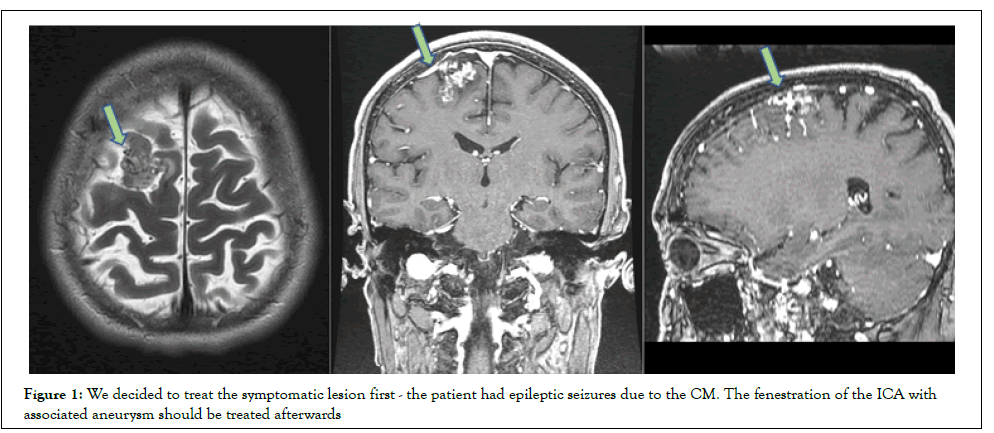
Figure 1: We decided to treat the symptomatic lesion first - the patient had epileptic seizures due to the CM. The fenestration of the ICA with associated aneurysm should be treated afterwards
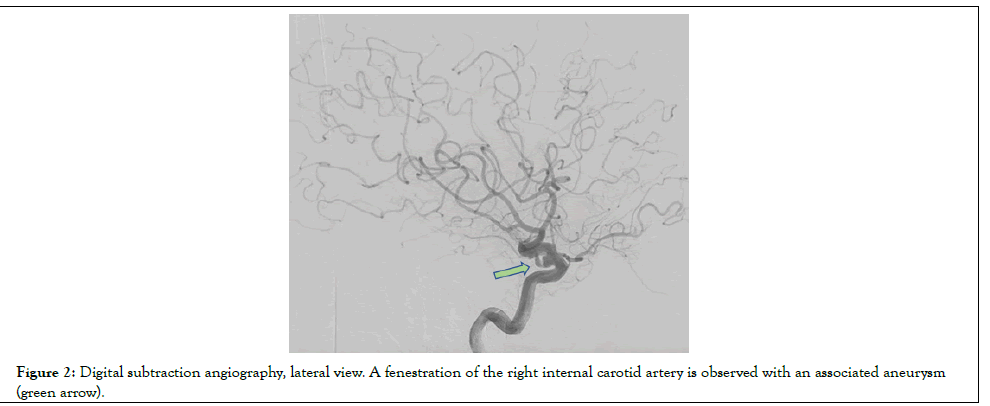
Figure 2: Digital subtraction angiography, lateral view. A fenestration of the right internal carotid artery is observed with an associated aneurysm (green arrow).
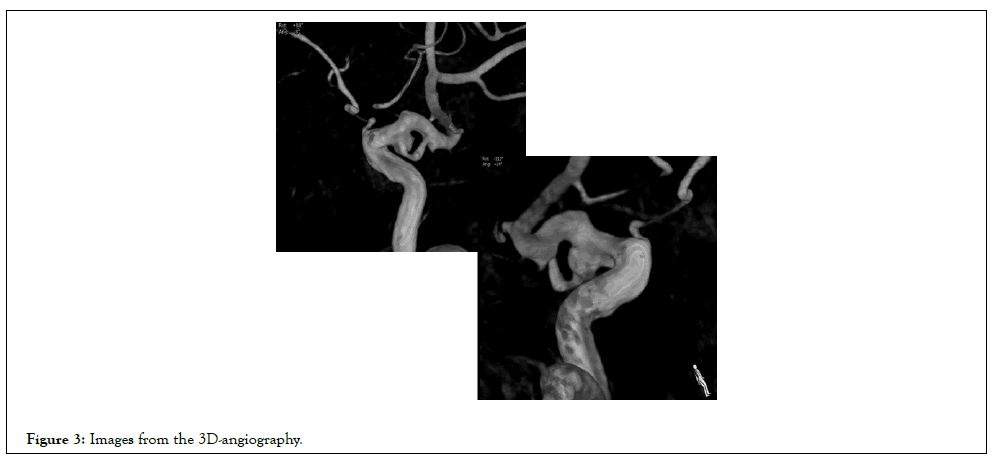
Figure 3: Images from the 3D-angiography.
The patient was operated on with complete removal of the CM which was confirmed by the histopathological examination. The postoperative period was uneventful. On Figure 4 is shown the early postoperative Computerized Tomography (CT) scan.
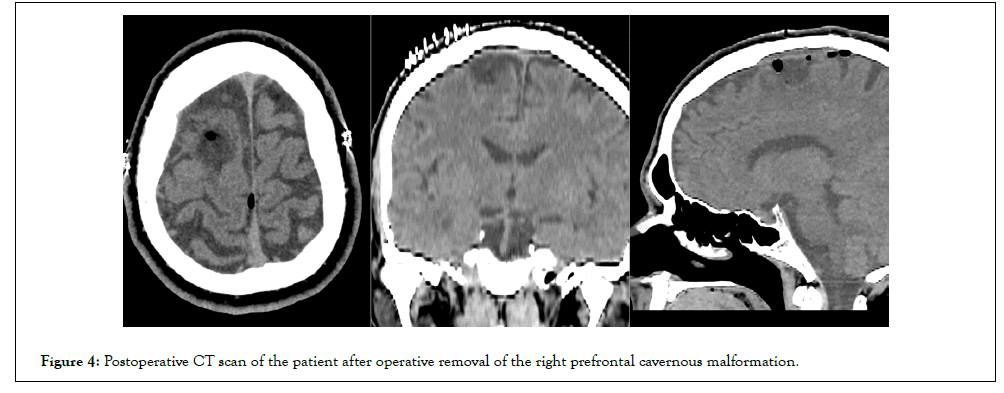
Figure 4: Postoperative CT scan of the patient after operative removal of the right prefrontal cavernous malformation.
We decided that the most appropriate treatment for the ICA fenestration and associated aneurysm would be endovascular flow- diversion. Two weeks postoperatively the patient was put on double antiplatelet therapy-Aspirin 100 mg and Clopidogrel 75 mg daily. An ADP test was performed preoperatively to rule out Clopidogrel resistance-the result was 15 and the patient continued taking Clopidogrel every other day. A Pipeline flow-diverter stent 4.25 mm × 16 mm was deployed in the right ICA, covering the fenestration and the associated aneurysm. Figure 5 includes intraoperative images that show the implanted flow-diverter and the already stagnating flow inside the aneurysm. The postoperative period was uneventful. The patient is continued on double antiplatelet therapy (Aspirin 100 mg/daily and Clopidogrel 75 mg/every other day) for 6 months. The follow-up DSA at 6 months is shown on Figures 6 and 7. The patient is symptom-free, seizure-free and is left only on Aspirin 100 mg/daily.
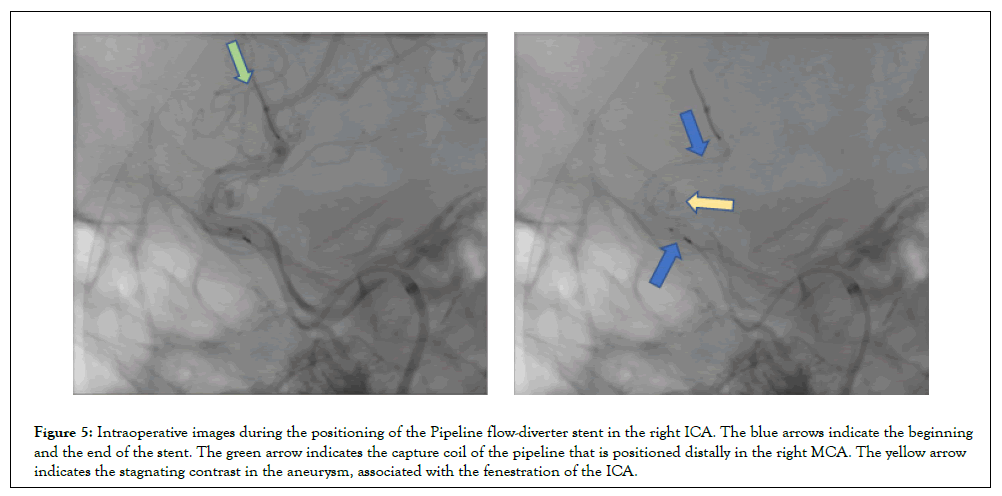
Figure 5: Intraoperative images during the positioning of the Pipeline flow-diverter stent in the right ICA. The blue arrows indicate the beginning and the end of the stent. The green arrow indicates the capture coil of the pipeline that is positioned distally in the right MCA. The yellow arrow indicates the stagnating contrast in the aneurysm, associated with the fenestration of the ICA.
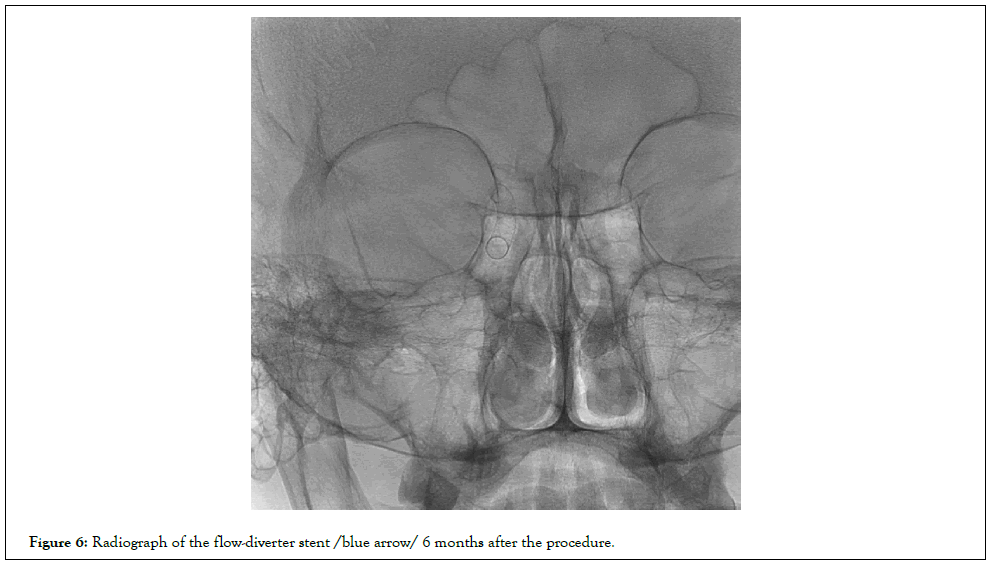
Figure 6: Radiograph of the flow-diverter stent /blue arrow/ 6 months after the procedure.
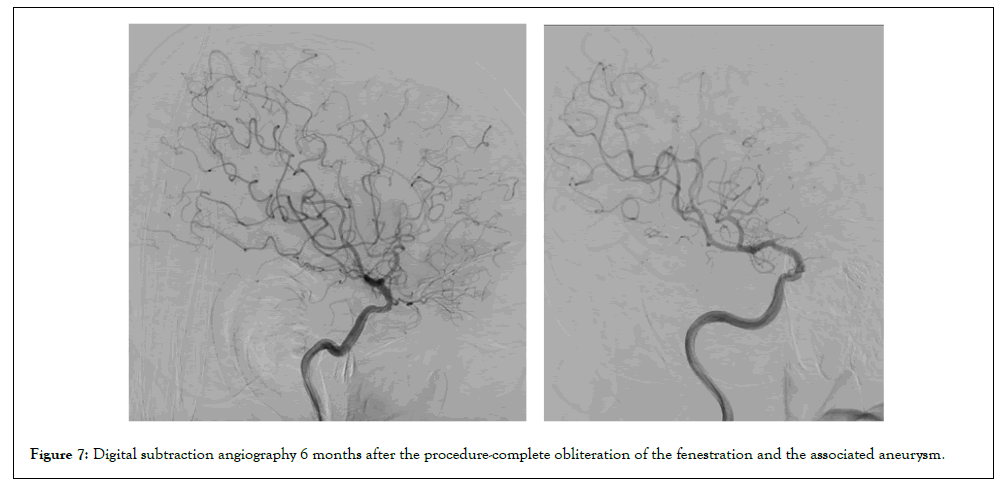
Figure 7: Digital subtraction angiography 6 months after the procedure-complete obliteration of the fenestration and the associated aneurysm.
Results and Discussion
Fenestration of the ICA is a rare anatomical variation (less than 2% of the intracranial arterial fenestrations), and it is even rarer with an associated aneurysm (13 cases) [1,2]. The incidence of intracranial arterial fenestration is 12.9% and is located mainly in the basilar artery and the anterior cerebral artery-in a study by Bozek in 1140 patients not a single case of ICA fenestration was found [7]. The presence of an ipsilateral CM is unique in the current case-in our knowledge this is the first reported case. Since 1984 only 13 cases of ICA fenestration with a flow-associated aneurysm have been reported so far, 4 ruptured and 9 unruptured [1,2,8]. All the aneurysms near a fenestration of the ICA have been treated so far-3 cases were wrapped, 3-clipped, 5-coiled, 1-wrapped and coiled, 1-clipped and coiled, and the last case from 2020 was treated with flow-diversion [1,2,8]. This is the second reported case of a fenestrated ICA treated with the implantation of a flowdiverter stent [1].
According to Ye, 16.4% of the patients with intracranial arterial fenestration could be affected by an ischemic complication [9]. Stroke is much more common in the presence of this anatomical variation involving the vertebrobasilar system.
Most publications about ICA fenestrations describe the association with other vascular malformations so careful angiographical observation is warranted [4,7]. On CT or MRI scans this anatomical variation could be mistaken for arterial dissection [4]. DSA and the 3D reconstructed images are the gold standard for diagnosing arterial fenestrations.
Fenestration of the ICA leads to hemodynamic stress that could be the explanation for the development of associated aneurysms. Four of the 14 aneurysms of this type reported so far have ruptured, which is 28.5%. Despite the small case load described until now treatment is warranted. The treatment options are neurosurgical clipping and endovascular treatment. From the described cases (13) all have been treated. In only one a flow-diverter stent was implanted.
Flow-diversion as a method for endovascular treatment of unruptured aneurysm or aneurysms with failed treatment is becoming more and more popular. This is mainly based on the multicenter trial (PITA trial) from 2011 [9]. The role of the flowdiverter stent is to reconstruct the hemodynamic flow inside the vessel and to allow neointimal proliferation leading to progressive separation of the aneurysm from the circulation. With the application of the Pipeline flow-diverter stent a 93% occlusion rate is reported at 6 months [9]. In accordance with this study, at our institution we have adopted the policy to make control DSA at 6 months and then annually until the 5th year. The presence of a vessel fenestration puts forward another problem-the selection of the main hemodynamic conduit. In the current case we did not have this problem as the main vessel was clearly visible. However, if the two channels of the fenestrated vessel are the same in size, the selection of the one in which to insert a flow-diverter stent if needed should be made very carefully, otherwise ischemic complication might occur postoperatively. Further investigation is needed concerning this topic if flow-diversion becomes the favored treatment option of flow-associated aneurysm in fenestrated ICA [10,11].
Conclusion
The combination of two types of vascular pathology in one patient that needs different treatment approaches/operative and endovascular/puts forward the question what to treat first. All aspects of the pathology itself (symptomatology, hemorrhagic risk, location, etc.) and the characteristics of the treatment (operative intervention, need for anticoagulation, etc.) should be taken into consideration.
In ICA fenestrations with associated aneurysm with a dominant arterial channel the implantation of a flow-diverter stent is an elegant method of eliminating the aneurysm from the circulation and restoring hemodynamics in the affected arterial segment.
References
- Kasper J, Nestler U, Meixensberger J, Quäschling U. Treatment of supraophthalmic internal carotid artery fenestration with an associated aneurysm via flow diversion: A case report. Int Med Case Rep J. 2021:487-491.
[Crossref] [Google Scholar] [Pub Med]
- Dey M, Awad IA. Fenestration of supraclinoid internal carotid artery and associated aneurysm: Embryogenesis, recognition, and management. World Neurosurg. 2011;76(6):592.e1-592.e5.
[Crossref] [Google Scholar] [Pub Med]
- Wu X, Lin A, Zhu J, Cai B. Basilar artery fenestration: An unusual possible cause of ischemic stroke? BMJ Case Rep. 2018;2018: bcr2017222910.
[Crossref] [Google Scholar] [Pub Med]
- Mărginean L, Filep RC, Constantin C, Bălaşa AF, Mühlfay G. Fenestration of the cervical internal carotid artery misdiagnosed as dissection. Rom J Morphol Embryol. 2020;61(1):257-260.
[Crossref] [Google Scholar] [Pub Med]
- Gao LY, Guo X, Zhou JJ, Zhang Q, Fu J, Chen WJ, et al. Basilar artery fenestration detected with CT angiography. Eur Radiol. 2013;23:2861-2867.
[Crossref] [Google Scholar] [Pub Med]
- Gold JJ, Crawford JR. An unusual cause of pediatric stroke secondary to congenital basilar artery fenestration. Case Rep Crit Care. 2013;2013.
[Crossref] [Google Scholar] [Pub Med]
- Patel MA, Caplan JM, Yang W, Colby GP, Coon AL, Tamargo RJ, et al. Arterial fenestrations and their association with cerebral aneurysms. J Clin Neurosci. 2014;21(12):2184-2188.
[Crossref] [Google Scholar] [Pub Med]
- Ole Nöldeke J, Lemcke J, Gräwe A, Gölz L, Gutowski P. An interdisciplinary approach to the treatment of a complex infraclinoidal internal carotid artery aneurysm. Neuroradiol J. 2019;32(5):376-381.
[Crossref] [Google Scholar] [Pub Med]
- Nelson PK, Lylyk P, Szikora I, Wetzel SG, Wanke I, Fiorella D. The pipeline embolization device for the intracranial treatment of aneurysms trial. Am J Neuroradiol. 2011;32(1):34-40.
[Crossref] [Google Scholar] [Pub Med]
- Bożek P, Pilch-Kowalczyk J, Kluczewska E, Zymon-Zagórska A. Detection of cerebral artery fenestrations by computed tomography angiography. Neurol Neurochir Pol. 2012;46(3):239-244.
[Crossref] [Google Scholar] [Pub Med]
- Ye D, Huang J, Wang S, Sheng S, Liu M. Cerebral arterial fenestration associated with stroke and other cerebrovascular diseases. Neuroreport. 2021;32(16):1279-1286.
[Crossref] [Google Scholar] [Pub Med]
Citation: Petrov M, Sakelarova T, Velinov N, Martinov I, Gabrovsky N (2023) A Rare Case of Flow-Diversion of a Fenestration of the Internal Carotid Artery with an Associated Aneurysm and a Resected Ipsilateral Cavernous Malformation. J Vasc Surg. S15:511.
Copyright: © 2023 Petrov M, et al. This is an open-access article distributed under the terms of the Creative Commons Attribution License, which permits unrestricted use, distribution, and reproduction in any medium, provided the original author and source are credited.

